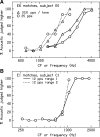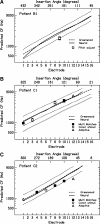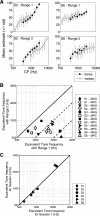Pitch comparisons between electrical stimulation of a cochlear implant and acoustic stimuli presented to a normal-hearing contralateral ear
- PMID: 20526727
- PMCID: PMC2975889
- DOI: 10.1007/s10162-010-0222-7
Pitch comparisons between electrical stimulation of a cochlear implant and acoustic stimuli presented to a normal-hearing contralateral ear
Abstract
Four cochlear implant users, having normal hearing in the unimplanted ear, compared the pitches of electrical and acoustic stimuli presented to the two ears. Comparisons were between 1,031-pps pulse trains and pure tones or between 12 and 25-pps electric pulse trains and bandpass-filtered acoustic pulse trains of the same rate. Three methods-pitch adjustment, constant stimuli, and interleaved adaptive procedures-were used. For all methods, we showed that the results can be strongly influenced by non-sensory biases arising from the range of acoustic stimuli presented, and proposed a series of checks that should be made to alert the experimenter to those biases. We then showed that the results of comparisons that survived these checks do not deviate consistently from the predictions of a widely-used cochlear frequency-to-place formula or of a computational cochlear model. We also demonstrate that substantial range effects occur with other widely used experimental methods, even for normal-hearing listeners.
Figures





References
-
- Burns EM, Viemeister NF. Played again SAM: Further observations on the pitch of amplitude-modulated noise. J Acoust Soc Am. 1981;70:1655–1660. doi: 10.1121/1.387220. - DOI
Publication types
MeSH terms
Grants and funding
LinkOut - more resources
Full Text Sources
Other Literature Sources
Medical

